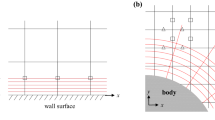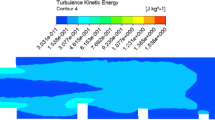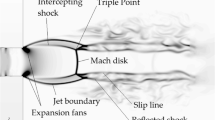Abstract
A novel approach to investigate turbulent flows in complex configurations is presented. It is based on the combined use of computer simulations and experimental measurements, and has the ability to produce, in a short period of time, large datasets in three-dimensional volumes. The measurements are based on magnetic resonance velocimetry whereas the computations use the immersed boundary technique. Both methods enable detailed analysis of flow fields in realistic configurations and can be used in a complementary way to identify regions of interest and perform design decisions. Direct comparisons between the experimental and numerical datasets are presented for the flow in a pipe and in a three-leg rib-roughened serpentine as a first step towards a more complete validation; the current limitations of the present approach are also discussed.
Similar content being viewed by others
References
Eggels, J.G.M., Unger, F., Weiss, M.H., Westerweel, J., Adrian, R.J., Friedrich, R., Nieuwstadt, F.T.M.: Fully developed turbulent pipe flow: A comparison between direct numerical simulation and experiment. J. Fluid Mech. 268, 175–209 (1994)
Elkins, C.J., Markl, M., Pelc, N., Eaton, J.K.: 4D magnetic resonance velocimetry for mean flow measurements in complex turbulent flows. Exp. Fluids 34, 494–503 (2003)
Kalitzin, G.: Validation and development of two-equation turbulence models. In: Haase, W., et al. (ed.) ECARP, Validation of CFD Codes and Assessment of turbulence models, Notes on Numerical Fluid Mechanics Series, vol. 57. Vieweg, Berlin, Germany (1997)
Kalitzin, G., Iaccarino, G.: Turbulence modeling in an immersed boundary RANS method. Annual Research Briefs, Center for Turbulence Research, 415–426 (2002)
Iaccarino, G., Verzicco, R.: Immersed boundary technique for turbulent flow simulations. Appl. Mech. Rev. 56, 331–347 (2003)
Iaccarino, G., Kalitzin, G., Moin, P., Khalighi, B.: Local Grid Refinement for an Immersed Boundary RANS Solver, AIAA Paper 2004-0586 (2004)
Iacovides, H., Raisee, M.: Recent progress in the computation of flow and heat transfer in internal cooling passages of turbine blades. Int. J. Heat Fluid Flow 20, 320–328 (1999)
Mittal, R., Iaccarino, G.: Immersed boundary method. Annu. Rev. Fluid Mech. 37, 239–261 (2005)
Stark, D., Bradley, W.: Magnetic Resonance Imaging. Mosby-Year Book, St. Louis (1999)
Wilcox, D.C.: Turbulence Modeling for CFD. DCW Industries (2002)
Wolhers, T.: CAD meets rapid prototyping. Comput. Aided Eng. 11(4), 43–57 (1992)
Elkins, C.J., Markl, M., Iyengar, A., Wicker, R., Eaton J.K.: Full-field velocity and temperature measurements using magnetic resonance imaging in turbulent compex internal flows. Int. J. Heat Fluid Flows 25(5), 702–710 (2004)
Author information
Authors and Affiliations
Corresponding author
Additional information
February 1, 2005.
Rights and permissions
About this article
Cite this article
Iaccarino, G., Elkins, C.J. Towards Rapid Analysis of Turbulent Flows in Complex Internal Passages. Flow Turbulence Combust 77, 27–39 (2006). https://doi.org/10.1007/s10494-006-9035-5
Accepted:
Published:
Issue Date:
DOI: https://doi.org/10.1007/s10494-006-9035-5




